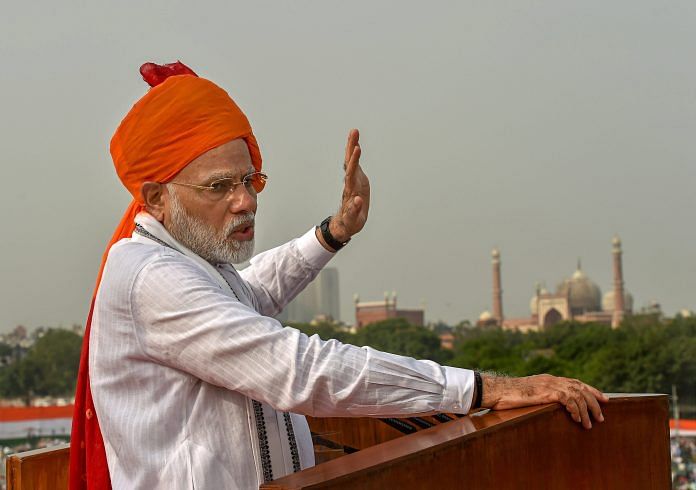Women judges are routinely passed over for promotions, making it impossible for them to move into bigger roles.
How many female judges do we need on the bench to claim that women are adequately represented in the Supreme Court?
While Prime Minister Narendra Modi might be convinced that three is a magic number, it is not even close enough to call it an achievement.
“Now, in a first, there are three women judges in the Supreme Court,” Modi said from the ramparts of the Red Fort on India’s 72nd Independence Day, perhaps in an attempt to woo his women voters.
Even if someone deserves a pat on the back for ensuring three female judges in the top court, that cannot be Modi.
Also read: Indu Malhotra: India’s 7th woman Supreme Court Judge in 70 years
However, three female judges in the country’s top court is no cause for celebration. Even with Justices R. Banumathi, Indu Malhotra and Indira Banerjee in the top court, women do not constitute even 10 per cent of all the judges.
So far, the Supreme Court has had only eight female judges, a statistic that flies in the face of our egalitarian constitutional goals.
In India’s judicial history, an all-women bench has held court only once, that too accidentally and just for a day. In 2013, when Justice Aftab Alam was on leave, the courts had to be rearranged and Justices Gyan Sudha Mishra and Ranjana Prakash Desai sat together.
Gender diversity in the judiciary
Women have relatively better representation in high courts and lower courts compared to the Supreme Court. However, even in the lower judiciary, women are hugely under-represented, constituting just 28 per cent, despite reservations.
Vidhi Centre for Legal Policy’s 2018 report ‘Tilting the scale: Gender imbalance in the lower judiciary’ notes that it is difficult for women to move up the ladder.
“Through its findings, a stark picture emerges of the abysmal representation of women in the lower judiciary, and we see a nearly uniform trend of the proportion of women judges decreasing as one moves up the levels of lower courts,” the report states.
Also read: The nauseating nepotism and caste-based discrimination that exists in Indian judiciary
This means women are routinely passed over for promotions, making it impossible for them to move into bigger roles.
Even after seven decades of Independence, the judiciary, which is ironically tasked with upholding the right to equality, is celebrating many firsts when it comes to women.
While some high courts are celebrating first woman chief justice, some are still celebrating first female judge. This year, Justice Indu Malhotra became the first female advocate to be appointed as a Supreme Court judge.
Although Modi wrongly claimed credit for bringing gender diversity, the blame for the sorry state of affairs lies squarely at the collegium’s doorstep.
In its three-decade-long existence, the collegium has had only one notable female judge – Justice Ruma Pal from 2004 to 2006. Ranjana Prakash Desai and Sujata Manohar were collegium members, but only for a few days before their retirement.
It is no surprise that the collegium, a male cabal, does not find enough capable women to appoint as judges. “She is not good enough,” is an oft-repeated excuse for overlooking some chief justices of high courts for elevation to the Supreme Court even when the court has at least half a dozen vacancies.
Also read: Reality check: Less than 12% of judges in SC and high courts are women
Last year, Delhi high court chief justice G. Rohini and Bombay high court chief justice Manjula Chellur were overlooked for elevation for reasons that will remain undisclosed.
Senior advocate and jurist Fali Nariman had once said in a closed-door lecture that equality is when “mediocre women take up all the big jobs, just like mediocre men do”.
While the collegium is blamed for making several “wrong” elevations, it continues to set the highest standards for women in an ecosystem that thwarts their performance at every level.
Given our abysmal record in the past, three female judges is indeed a good start.
But only an all-woman Supreme Court with 30 female judges and a female chief justice should be hailed as truly representative. If that seems a bit too much, remember that the Supreme Court has in the past been an all-male court, several times over, and no one seemed to even blink.
It is too soon to celebrate gender diversity in the judiciary.







Becoming a supreme court judge is not poll vault or long jump. It needs certain conditions to be fulfilled and willingness to become judge leaving lucrative practice. Instead of criticising the government, the writer should come out with clear statistics that how many lady lawyers are there satisfying the conditions and how many are willing to leave their practice and take really onerous responsibility of becoming a judge. The judge’s job is really thankless and not rewarding. Now a trend has begun and in days to come, the numbers will go up. Hope for the best.
Three woman in Supreme Court as a judge is a big positive step towards empowerment of women in Supreme Court